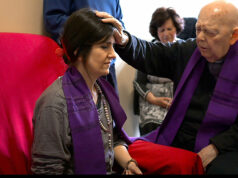Our sacred churches in the Holy Land might not even exist if it were not for the journeys of one remarkable woman: St. Helena.
Helena was born in Asia Minor, what is modern-day Turkey, to a middle-class family in 248 AD.
Historic accounts of how she met her husband, Roman Emperor Constantius, vary, but she eventually became his wife and gave birth to the future Constantine I. After 22 years of marriage, her husband divorced her, and she and her son were sent away to a neighboring court.

After her husband’s death, Constantine assumed the throne and elevated his mother’s place in his court, giving her the title of Augusta. This title was a high honor which gave Helena all the power of an emperor, complete with her own staff and funds. Constantine even had coins cast in his mother’s image.
Helena was a convert to Christianity, as was her son. It is not clear who became a Christian first, Helena or Constantine. In some accounts, she led him to the faith; in others, he was the influence on her. Legend says after seeing a Christian symbol in a dream, he had it painted on his soldier’s shields and they were protected in battle. What is known is that the Roman Empire became Christian under his rule, and persecution of Christians ceased.
Her royal title afforded Helena the power and funds she necessary to travel and establish churches in the Holy Land. In her 70s, Helena travelled to Jerusalem, which had been ravaged, to search for relics and re-establish its rightful place as the birth of Christianity. Jerusalem had previously been ravaged by the Roman army in the Roman-Jewish wars.
Helena had many churches built in her travels; she is the patron of the Church of the Nativity, and the Church of Eleona on the Mount of Olives. In her quest to find the True Cross, stories say that Helena was presented with three crosses. In order to determine what one was true, she found a sick woman and requested she touch all three. When the woman touched the third cross, she was healed, and Helena declared that was the True Cross. Constantine declared that a church be built at the site, what we now know as the Church of the Holy Sepulchre.
Helena returned to Rome with what she believed to be relics of the True Cross, along with other relics believed to have ties to Jesus.
Helena died not long after her journeys to the Holy Land. She was buried in the Mausoleum of Helena just outside Rome. Her sarcophagus can be seen in the Pio-Clementine Vatican Museum.
St. Helena’s feast day is Aug. 18
She is the patron of difficult marriages, divorced persons, converts, and archaeologists.
Read here biography at Franciscan Media here:
The diocese of Helena in Montana brings us this prayer to St. Helena: https://diocesehelena.org/2018/10/10/prayer-to-st-helena/








